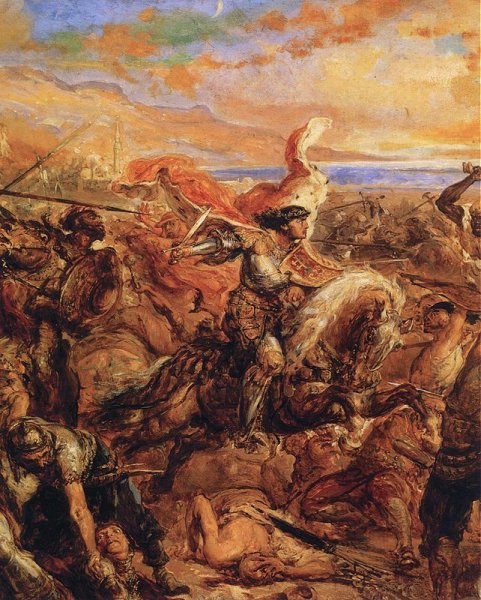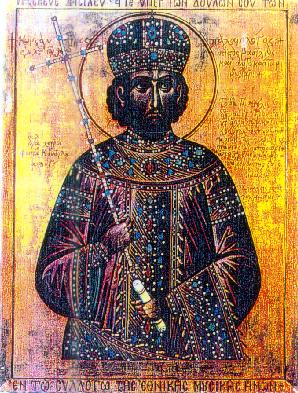The Walls of Constantinople (Κωνσταντινούπολις ) 2nd partie
French Version
1st part HERE
Thanks to Nuray
Walk Around HERE
.png) |
| Source Internet |
the Mesoteichion "Middle Wall"
The stretch of walls between the Gate of St. Romanus and the Gate of Charisius, with a length of 1,250 metres, was known as the Mesoteichion ("Middle Wall"). It was considered as the weakest part of the walls, because the ground descended towards the valley of the Lycus River, and as a result the walls lay lower than the opposing slopes. It was here that Mehmed II had placed most of his artillery, and as a result, much of this portion of the walls lies still in ruins today.
With the advent of siege cannons, however, the fortifications became obsolete, but their massive size still provided effective defence, as demonstrated during the Second Ottoman Siege in 1422. In the final siege, which led to the fall of the city to the Ottomans in 1453, the defenders, severely outnumbered, still managed to repeatedly counter Turkish attempts at undermining the walls, repulse several frontal attacks, and restore the damage from the siege cannons for almost two months.
.jpg) |
| Coats of arms Giustinani |
Finally, on 29 May, the decisive attack was launched, and when the Genoese general Giovanni Giustiniani was wounded and withdrew, causing a panic among the defenders, the walls were taken. After the capture of the city, Mehmet repaired walls but in short order
The Walls of Blachernae
.jpg) |
In the northwestern corner of the city, the suburb of Blachernae with its important church of Panagia Vlacherniotissa was left out of the Theodosian walls.
To defend it, in the face of the great Avar siege, a single wall was built, around 627, in the reign of Heraclius. In 814, Leo V the Armenian built a new wall in front of the Heraclean one to safeguard against Bulgarian raids.
In the 12th century, when Blachernae had become the favourite imperial residence, Manuel I Komnenos built a wall, starting from the end of the Theodosian Walls, to protect the imperial palaces, which was connected by a later wall (possibly under Isaac II Angelos) to the Heraclean wall.[18] Despite all this, the defences of the Blachernae section remained weaker than at the Theodosian Walls, and it was here the Crusaders of the Fourth Crusade managed to penetrate them and first enter the city.
The Walls of Blachernae consist of four single walls built in different periods. Generally they are about 12-15 metres in height; thicker than the Theodosian Walls and with more closely spaced towers, while lacking a moat. The fortification begins at the end of the Theodosian Walls with the Komnenian Wall, connected by the Angelian wall to the Heraclean wall, which in turn is connected to the Sea Walls at the Golden Horn. The wall of Leo V lies in front of the Heraclean wall.
The wall of Manuel Komnenos is an architecurally-excellent fortification, extending for 220 m, with 9 towers, the small gate (paraportion) of St. Kallinikos between the second and third towers, and one gate after the sixth tower, the modern Crooked Gate , which is identified with the old Kaligaria Gatethe "Gate of the Bootmakers' Quarter".
The Komnenian wall ends at the third tower from the gate, and the newer wall (from the late 12th century), architecturally much inferior, continues for ca. 400 metres. This wall has four square towers and a gate, the Gyrolimne Gate (Silver Lake) between the second and third of them, now walled up, which led to the Blachernae Palace.The last stretch of the wall is adjoined by two structures
The Tower of Isaakios Angelos, built around 1188 as a residence for the Emperor, and the nearby building and tower known as Prisons of Anemas, dated to the 7th century but named after Michael Anemas, a general of Alexios I who was imprisoned there after a failed plot against the Emperor.
The wall of Heraclius begins from there and extends for about 100 metres to the Sea Walls. It has three strong hexagonal towers, and the Gate of Blachernae . The wall of Leo V complements it from the outside, forming a sort of rectangular fort, with an internal space of ca. 25 metres between the two walls. At the edge of the Leontian wall stands the Tower of St. Nicholas, originally built by Leo V and rebuilt by Emperor Romanus I Lecapenus. The Leontian Wall is thinner and of inferior construction to the Heraclean, and features four small towers along with a now collapsed gate, which formed the outer counterpart of the Blachernae Gate. Since the Sea Walls at the Golden Horn were built at a distance from the shore, a wall extended from the end of the Land Walls to the shoreline, the so-called Vrakhiolion, erected at the same time as the main Heraclean wall, in 627. It had a single gate, the "Wooden Gate" (Xyloporta).
Repairing and maintaining the walls
The walls of Constantinople were to be keep after So it was choose an officers, known as Governors of the Walls or Counts of the Walls,
His job: taking charge of repairs and maintenance. During the 1000 years of the Byzantium Empire most of the damage the walls sustained came from the effects of weather or earthquakes, not war.
The walls were so strong that little battle damage was sustained until very late in their history when gunpowder was employed.
Earthquakes are more dangerous
the principals operations took place in 542, 554 558. Damages of the 4th Crusade in 1204 were important 1/6 of the area of Constantinople was ravaged by fire and between 1/6 and 1/9 of its buildings destroyed. The repair of the walls was one of the new emperor's top priorities.
.gif) |
| Prise de Constantinople (1204) |
But the Empire was in bankruptcy
The land and sea walls were in bad The Empire was in bankruptcy so Michael VIII (Μιχαήλ Η΄ Παλαιολόγος 1224 1282) immediately ordered that the height of the sea walls be increased by about 2.13m by the addition of wooden screens and a second line of sea walls built
Later sections around the Blachernae Palace were also repaired
In 1317 after the death of Empress Irene, a large sum of money was devoted to the restoration of the walls
But the most extensive work in the wall's history took place in 1345 when the entire length of the walls was repaired and strengthened in the face of an attack by a rival emperor.
An the last restoration take place in 1441 with John VII Palaeologus( 1370-1418)
Just before the fall of Constantinople in 1453 the outer wall received the major attention on this occasion.
Wall Now
The wall runs through the suburbs of modern Istanbul, with a belt of parkland flanking their course. The walls are pierced at intervals by modern roads leading westwards out of the city.
The walls were largely maintained intact during most of the Ottoman period, until sections began to be dismantled in the 19th century, as the city outgrew its medieval boundaries. Despite the subsequent lack of maintenance, many parts of the walls survived and are still standing today. A large-scale restoration program has been under way since the 1980s, which allows the visitor to appreciate their original appearance.
But the restoration program has been criticized for use of inappropriate materials and poor quality of work and destroying historical evidence, ; During the earthquake of 1999 some restored sections collapsed while the original structure underneath remained intact
The Ananstasian Wall
.jpg) |
It is like the Hadrian Wall and it is few know
The monument known in antiquity as either the Long Walls of Thrace or the Anastasian Wall lies 65 km west of Istanbul and stretches from the Black Sea coast across the peninsula to the coast of the Sea of Marmara to the west of Silivri. The Wall is part of the additional defenses for Constantinople constructed during the 5th century AD and probably continued in use until the 7th century.
Originally the Wall was around 56 km long, but less than half of the total length now survives above ground. It is best preserved in the rolling woodland of the northern sector where the Wall stands in place up to 4m in height. Associated with the Wall is a well preserved ditch, outerwork, gates and forts. As it survives it is the most monumental linear fortification dating from antiquity in continental Europe, comparable only with Hadrian's Wall in its complexity and preservation. Recent road construction and other developments associated with the expansion of Greater Istanbul are now posing a major threat to the surviving remains.
By the 6th century AD Constantinople (modern Istanbul) had surpassed Rome as the most eminent city in the late Roman world. Protecting the wealth of the city was paramount to its prosperity in the long term and the Anastasian Wall was built as a new and forbidding line of defense, to supplement the city's existing fortifications in the face of increasing threats to the security of the hinterland
When the emperor Anastasius (AD 491-518) ordered the construction of the Wall, probably to counter the hightened military pressure from the Bulgars, he was responding as others had in the past to the threat of "barbarian" incursion. In the second century AD Hadrian had built such a linear fortification in northern Britain and others were constructed in the Alps and Balkans from the 4th century onwards. The Wall was frequently attacked in the 6th century and although the successful resistance of "barbarian" assault is recorded in historical texts, the failures of the barrier are more vividly reencountered. The great length of the Wall clearly made it difficult both to maintain and to garrison effectively. Although new evidence attests to some restoration on the Wall in the early 7th century, this represents the last years of Byzantine presence on the Anastasian Wall and defensive emphasis would soon to retreat to the city's Land Walls.
Chronology
324 Constantine moves the capital of the Roman Empire to Byzantium
325 New walls are built
378 Battle of Adrianople
405 Anthemius begins the Theodosian Walls
423 Completion of the Theodosian Walls
447 Much of the walls destroyed by an earthquake
626 Siege by the Persians and Avars
627 Building of the Wall of Heraclius
674 Siege by the Arabs begins
678 Use of Greek fire ends the Arab siege
714 Second siege by the Arabs
813 LeoV adds outer wall in Blachernae Quarter. Siege by Krum the Bulgar
860 Siege by the Russians
1047 Siege by Leo Tornices
1081 Alexius Comnenus enters Constantinople
1097 First Crusade threatens Constantinople
1204 Fourth Crusade takes Constantinople
1261 Constantinople recaptured from the Latins
1345 Extensive repairs carried out to walls
1351 Repairs to sea walls
1390 First use of gun powder at Constantinople
1396 Siege by Bayezid the Thunderbolt. Battle of Nicopolis
1422 Siege by Murad II
1444 Battle of Varna
 Battle Battle |
| Battle of Varna Internet |
1453 Constantinople falls to Mehmet the Conqueror
Walk Around Phototheque HERE ICI






.png)
.jpg)
.jpg)
.gif)
.jpg)
.gif)
.jpg)
.jpg)
.jpg)
 Battle
Battle
.jpg)
.jpg)